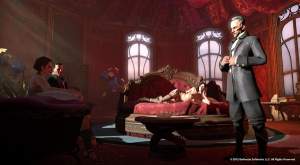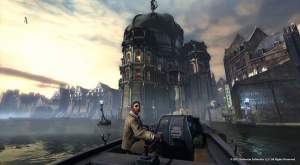To celebrate the launch of Bethesda’s latest blockbuster, the Guardian Xtra is hosting a very special behind the scenes event at their HQ next week.
Lead designers from French studio Arkane, Art Director Sebastien Mitton and Visual Design Director Viktor Antonov will lead an informal talk and Q&A, sharing what’s inspired them and how this has informed retro-futuristic architecture in the soon-to-be-released Dishonored. Xtra members will also see new pieces of previously unseen concept art from early stages of the game’s development, plus as an extra treat, a brand new piece of concept art that re-imagines an iconic London landmark has been created especially by Arkane for the event and will be given away on the evening as a signed canvas!

SFL: We’re really looking forward to hearing more about your work at the Xtra event next week. There seems to be a huge interest in the art style of Dishonored. Many people are describing the design as 'Steampunk' due to its brass, industrial feel. Do you agree is this accurate?
Sebastien Mitton: The result seems accurate, but the intention was different. As you may know, the game was initially set in London in 1666, but we slowly shifted away from that to incorporate our sci-fi elements. This was originally called the “Oppression Layer,” then “Neo Victorian” due to the cohabitation of the Jacobean architecture with some retro-future devices.
What dystopian Sci-Fi/technology influences are there in the game?
At the time the plot of the game became solid, we developed some major themes such as oppression, verticality, and death, as well as nostalgia and romanticism to keep the contrast as high as possible. These themes are vectors for the visual storytelling.
Rat-lights, street speakers, guard booths, checkpoints, armored cable-cars, walls of light and street blockers are examples of elements that convey dystopia in our world.
What was it about London, specifically during the plague that you drew inspiration from visually?
We’ve read a lot about the daily life in London during this period, like stories about the Roaring Boys and the protected guests in Goldsmith’s Row. Quarantines, closed districts, sealed buildings, and street blockers are all concepts we read a lot about during preproduction.
One of our main references is from London: The Biography by Peter Ackroyd, and also the testimonies from two families exposed to the great Plague.
Another one about the city’s structure is “The Sewer King” episode from the “Seven Wonders of the Industrial World” documentary series about cholera and this awesome architect who drove the sewer construction in London.
How did this inform the painted art style and hand drawn processes?
Part of my art direction is to avoid procedural and direct use of photography which comes from my academic background. Most of our references are from painters and pulp illustrators: Buland, Meissonnier, Dean Cornwell, Mead Schaeffer, Gerome, Dagnan Bouveret, Detaille, Neuville, Canalett, etc.

Regarding our models, it’s not only the textures that give this feeling of a vibrant painting, but also the way we sculpt things. All along the process of character creation - from early rough to the final model - we keep focusing on legibility, silhouettes and planes, like academic sculptors. That’s where the sculpting phase is really important, because lights magnify your visual intentions. It’s all about finding the balance between realism and style.
Some members of the development team worked on 'Deus Ex' - did they bring a flavour of that game to Dishonored or was the intention always to create something completely new?
Some coworkers worked on Deus Ex as game-designers and level designers. It has indirectly impacted the art, as their demand was in the vein of the Deus Ex design style. So yes, we share the same philosophy, but art-wise Dishonored is a fresh new experience in a world built from scratch.
Thanks to Sebastien for chatting to us. Dishonored is already gaining critical acclaim for its fresh, unique and bold approach. To coincide with the launch, Bethesda are also presenting a three-part animated webisode series, narrated by narrated by Chloe Grace Mortez (Kick Ass) entitled "The Tales from Dunwall" to give players some background and context before the release date.
To hear and see more from the game’s art team, make sure you head over to the Guardian Xtra event page to reserve your place for the 3rd October.
Food and drink will be served after the presentation. Tickets cost £8. See you there!
Dishonored will be released on October 12 Xbox 360, PlayStation 3, and PC.